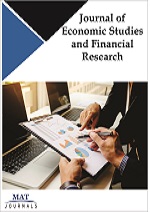Exploring the Interconnected Dynamics and Long term Implications of Financial Literacy, Retirement Planning, and Household Wealth
DOI:
https://doi.org/10.46610/JESFR.2025.v06i02.005Keywords:
Financial education, Financial literacy, Household wealth, India, Personal finance, Planning for retirement, Socio economic dynamics, Stock market participation, Wealth accumulationAbstract
Financial literacy plays a pivotal role in shaping household wealth and retirement planning, particularly in emerging economies like India. This study examines the connection between wealth accumulation in Indian households, retirement planning practices, and financial literacy. Leveraging comprehensive financial literacy measures, the study highlights the impact of financial knowledge on wealth management and the critical role of retirement planning in long term financial security. By analyzing data on financial behavior, this paper provides new insights into how informed decision making can drive wealth accumulation, particularly through stock market participation and structured retirement plans. Additionally, the findings indicate the significance of focused financial education programs intended to enhance household financial outcomes, particularly in a diverse socio economic landscape such as India.
References
Lusardi, A. (2003). Planning and saving for retirement. Working Paper, Dartmouth College. https://static.twentyoverten.com/5df7ffacb22b20786b33bcac/6YoHI1IFiT/Lusardi_pdf.pdf
Agarwal, S., Amromin, G., Ben-David, I., Chomsisengphet, S., & Evanoff, D. D. (2015). Financial literacy and financial planning: Evidence from India. Journal of Housing Economics, 27, 4-21. https://doi.org/10.1016/j.jhe.2015.02.003
Lusardi, A., & Mitchell, O. S. (2007a). Baby boomer retirement security: The role of planning, financial literacy, and housing wealth. Journal of Monetary Economics, 54(1), 205-224. https://doi.org/10.1016/j.jmoneco.2006.12.001
Schleicher, A. (2020). The Impact of COVID-19 on Education: Insights from" Education at a Glance 2020". OECD Publishing. https://eric.ed.gov/?id=ED616315
Alessie, R., Lusardi, A., & Kapteyn, A. (1999). Saving after retirement: Evidence from three different surveys. Labour Economics, 6(2), 277-310. https://doi.org/10.1016/S0927-5371(99)00013-5
Ameriks, J., Caplin, A., & Leahy, J. (2003). Wealth accumulation and the propensity to plan. Quarterly Journal of Economics, 118(3), 1007-1047. https://www.jstor.org/stable/25053929
Ameriks, J., Caplin, A., Leahy, J., & Tyler, T. (2007). Measuring self-control problems. American Economic Review, 97(3), 966-972. https://www.aeaweb.org/articles?id=10.1257/aer.97.3.966
Padma, D., & Pattammal, V. (n.d.) Bridging the Gender Gap in Financial Literacy: An Analytical Study of Barriers, Behavioral Impact, and Inclusive Interventions for Women. Financial Empowerment: The Role of Women in Shaping Contemporary Economic Paradigms, 34-42. https://doi.org/10.34293/9789361634925.ch.008
Agnew, J., Szykman, L., Utkus, S. P., & Young, J. (2007). Literacy, trust and 401(k) savings behavior. Center for Retirement Research Working Paper, 2007-10, Boston. https://crr.bc.edu/wp-content/uploads/2007/05/wp_2007-10_2009.pdf
Bernheim, B. D. (1995). Do households appreciate their financial vulnerabilities? An analysis of actions, perceptions, and public policy. Tax Policy and Economic Growth, American Council for Capital Formation, Washington, DC, 1-30. https://bernheim.people.stanford.edu/publications/do-households-appreciate-their-financial-vulnerabilities-analysis-actions-perceptions
NS, N., SP, A., Sinha, D., Veedin Rajan, V. B., Esthaki, V. K., & D’Silva, P. (2012). HSPIR: a manually annotated heat shock protein information resource. Bioinformatics, 28(21), 2853-2855. https://doi.org/10.1093/bioinformatics/bts520
Bernheim, B. D. (1998). Financial illiteracy, education, and retirement saving. O. Mitchell & S. Schieber (Eds.), Living with Defined Contribution Pensions (pp. 38-68). University of Pennsylvania Press. https://repository.upenn.edu/entities/publication/1eabb67b-f1fd-4adc-bf8c-db2dc3c4e1c1
Binswanger, J., & Schunk, D. (2008). What is an adequate standard of living during retirement? Cambridge University Press, 2008-82. https://doi.org/10.1017/S1474747211000618
Duflo, E., & Saez, E. (2003). The role of information and social interactions in retirement plan decisions: Evidence from a randomized experiment. Quarterly Journal of Economics, 118(3), 815-842. https://doi.org/10.1162/00335530360698432
Hans, V. (2023). Niti Aayog. Niti Aayog (December 5, 2023). http://dx.doi.org/10.2139/ssrn.4653934
Bernheim, B. D., & Garrett, D. M. (2003). The effects of financial education in the workplace: Evidence from a survey of households. Journal of Public Economics, 87(7-8), 1487-1519. https://doi.org/10.1016/S0047-2727(01)00184-0
Barber, B. M., & Odean, T. (2001). Boys will be boys: Gender, overconfidence, and common stock investment. Quarterly Journal of Economics, 116(1), 261-292. https://doi.org/10.1162/003355301556400
Alessie, R., van Rooij, M., & Lusardi, A. (2011). Financial literacy and retirement preparation in the Netherlands. Journal of Pension Economics and Finance, 10(4), 527-545. https://doi.org/10.1016/j.joep.2011.02.004
Bernheim, B. D., Garrett, D. M., & Maki, D. M. (2001). Education and saving: The long-term effects of high school financial curriculum mandates. Journal of Public Economics, 80(3), 435-465. https://doi.org/10.1016/S0047-2727(00)00120-1
Clark, R. L., & D’Ambrosio, M. B. (2008). Adjusting retirement goals and saving behavior: The role of financial education. In A. Lusardi (Ed.), Overcoming the Saving Slump: How to Increase the Effectiveness of Financial Education and Saving Programs (pp. 237-256). University of Chicago Press. https://doi.org/10.7208/chicago/9780226497105.003.0009
Hilgert, M. A., Hogarth, J. M., & Beverly, S. G. (2003). Household financial management: The connection between knowledge and behavior. Federal Reserve Bulletin, 89, 309-322. https://ideas.repec.org/a/fip/fedgrb/y2003ijulp309-322nv.89no.7.html?pagewanted=all
Calvet, L. E., Campbell, J. Y., & Sodini, P. (2007). Down or out: Assessing the welfare costs of household investment mistakes. Journal of Political Economy, 115(5), 707-747. https://doi.org/10.1086/524204
Campbell, J. Y. (2006). Household finance. Journal of Finance, 61(4), 1553-1604. https://scholar.harvard.edu/files/campbell/files/householdfinance_jof_2006.pdf
Benartzi, S., & Thaler, R. H. (2004). Save more tomorrow: Using behavioral economics to increase employee saving. Journal of Political Economy, 112(1), S164-S187. https://www.journals.uchicago.edu/doi/abs/10.1086/380085
Haliassos, M., & Bertaut, C. C. (1995). Why do so few hold stocks? Economic Journal, 105(432), 1110-1129. https://doi.org/10.2307/2235407
Lusardi, A., & Mitchell, O. S. (2007b). Financial literacy and retirement preparedness: Evidence and implications for financial education. Business Economics, 42(1), 35-44. https://link.springer.com/article/10.2145/20070104
Barsky, R. B., Juster, F. T., Kimball, M. S., & Shapiro, M. D. (1997). Preference parameters and behavioral heterogeneity: An experimental approach in the Health and Retirement Study. Quarterly Journal of Economics, 112(2), 537-579. https://doi.org/10.1162/003355397555280
Barber, B. M., & Odean, T. (2000). Trading is hazardous to your wealth: The common stock investment performance of individual investors. Journal of Finance, 55(2), 773-806. https://doi.org/10.1111/0022-1082.00226




